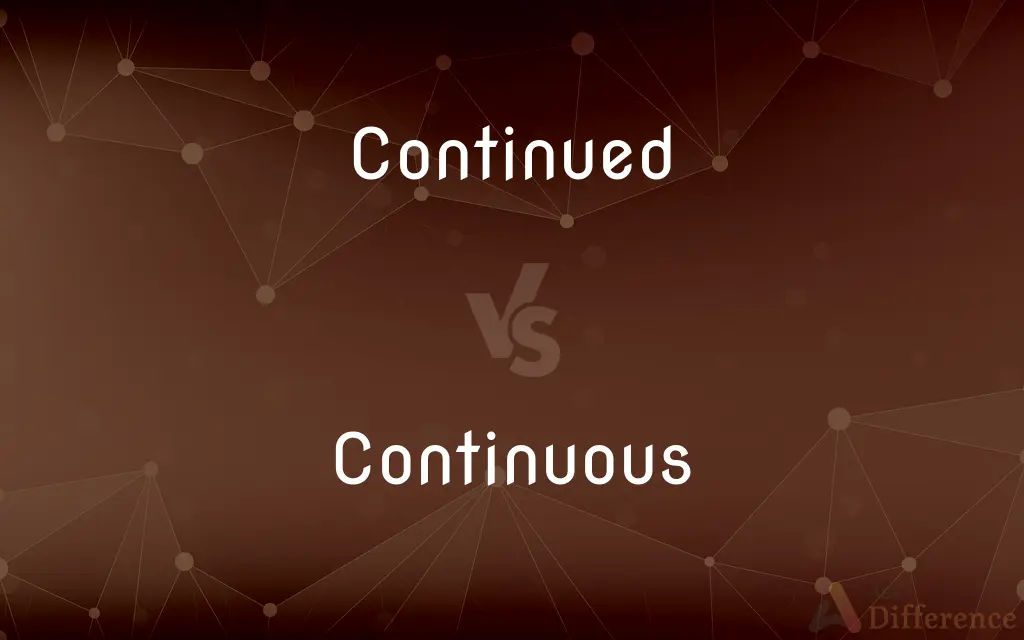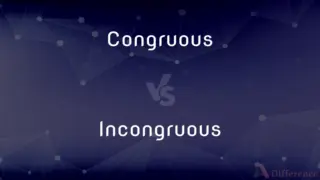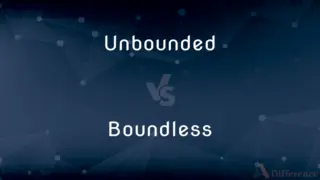Continued vs. Continuous — What's the Difference?
By Tayyaba Rehman — Updated on October 7, 2023
Continued means carried on or extended, while Continuous refers to something unbroken or without interruption.

Difference Between Continued and Continuous
Table of Contents
ADVERTISEMENT
Key Differences
Continued generally implies that something is being extended or carried on from a prior point, indicating a progression or sequence. Continuous, in contrast, emphasizes the unbroken nature of an action, event, or condition, highlighting its uninterrupted and constant nature.
While Continued often suggests a resumption or extension, Continuous denotes an ongoing, seamless process.
For instance, a Continued story in a magazine picks up from where it left off, whereas a Continuous noise persists without any breaks.
Comparison Chart
Part of Speech
Adjective, verb (past tense)
Adjective
Meaning
Extended or carried on
Unbroken, without interruption
ADVERTISEMENT
Temporality
Suggests a sequence or resumption
Emphasizes constant occurrence
Usage in Narration
Often used for stories or events
Used to describe constant actions/events
Examples
Continued effort, continued on page 12
Continuous noise, continuous improvement
Compare with Definitions
Continued
Continued implies resumed.
The series Continued with a new episode.
Continuous
Continuous highlights constancy.
The river flowed in a Continuous stream.
Continued
Continued denotes carried on.
They Continued their journey after a short break.
Continuous
Continuous denotes ongoing.
The Continuous development of technology is astounding.
Continued
Continued can suggest persistence.
He Continued his attempts to solve the problem.
Continuous
Continuous implies without interruption.
The Continuous music played all night.
Continued
Continued highlights progression.
The Continued growth of the company is impressive.
Continuous
Continuous refers to incessant.
The Continuous chatter was distracting.
Continued
To go on with a particular action or in a particular condition; persist
We continued until the job was finished.
Continuous
Uninterrupted in time, sequence, substance, or extent.
Continued
To exist over a period; last
The meeting continued for another hour.
Continuous
Attached together in repeated units
A continuous form fed into a printer.
Continued
To remain in the same state, capacity, or place
She continued as mayor for a second term.
Continuous
Of or relating to a line or curve that extends without a break or irregularity.
Continued
To go on after an interruption; resume
The negotiations continued after a break for dinner.
Continuous
Of or relating to a function between two topological spaces such that the preimage of any open set in the range is an open set in the domain.
Continued
To extend in a given direction
The stream continues for another five miles before it reaches the lake.
Continuous
Without stopping; without a break, cessation, or interruption.
A continuous current of electricity
Continued
To carry on; persist in
The police will continue their investigation. I continued reading all afternoon.
Continuous
Without intervening space; continued.
A continuous line of railroad
Continued
To carry further in time, space, or development; extend
The builder will continue the road right through the swamp.
Continuous
(botany) Not deviating or varying from uniformity; not interrupted; not joined or articulated.
Continued
To cause to remain or last; retain or maintain
Are you continuing the prescription? The team continued its dominance over its opponents.
Continuous
Such that, for every x in the domain, for each small open interval D about f(x), there's an interval containing x whose image is in D.
Continued
To carry on after an interruption; resume
After a break for lunch, we continued our hike.
Continuous
Such that each open set in the target space has an open preimage (in the domain space, with respect to the given function).
Each continuous function from the real line to the rationals is constant, since the rationals are totally disconnected.
Continued
(Law) To postpone or adjourn.
Continuous
(grammar) Expressing an ongoing action or state.
Continued
(dated) Prolonged; unstopped.
Continuous
Without break, cessation, or interruption; without intervening space or time; uninterrupted; unbroken; continual; unceasing; constant; continued; protracted; extended; as, a continuous line of railroad; a continuous current of electricity.
He can hear its continuous murmur.
Continued
Uninterrupted.
Continuous
Not deviating or varying from uninformity; not interrupted; not joined or articulated.
Continued
Simple past tense and past participle of continue
Continuous
Continuing in time or space without interruption;
A continuous rearrangement of electrons in the solar atoms results in the emission of light
A continuous bout of illness lasting six months
Lived in continuous fear
A continuous row of warehouses
A continuous line has no gaps or breaks in it
Moving midweek holidays to the nearest Monday or Friday allows uninterrupted work weeks
Continued
The word continued when placed in the end of the page to show it is to be continued
Continuous
Of a function or curve; extending without break or irregularity
Continued
Having extension of time, space, order of events, exertion of energy, etc.; extended; protracted; uninterrupted; also, resumed after interruption; extending through a succession of issues, session, etc.; as, a continued story.
Continuous
Continuous means unbroken.
The Continuous line was drawn without lifting the pen.
Continued
Without stop or interruption;
To insure the continued success of the war
The continued existence of nationalism
The continued popularity of Westerns
Continued
Continued means extended.
The meeting Continued for another hour.
Common Curiosities
What forms can Precipitation take?
Precipitation can be rain, snow, sleet, hail, or drizzle.
Is Precipitation always associated with high Cloudiness?
No, even light cloud cover can produce Precipitation if the clouds are moisture-laden.
What does Cloudiness measure?
Cloudiness measures the amount of the sky covered by clouds.
What causes Precipitation to occur?
Precipitation occurs when moisture in the atmosphere condenses and falls due to gravitational pull.
Is Cloudiness solely a daytime phenomenon?
No, Cloudiness can occur at any time, day or night.
Does high Cloudiness always indicate a storm?
No, high Cloudiness can occur without an impending storm or Precipitation.
Can a clear sky with no Cloudiness produce Precipitation?
No, Precipitation originates from clouds, so some Cloudiness is required.
Can there be Cloudiness without Precipitation?
Yes, an overcast sky doesn't guarantee rain or other forms of Precipitation.
Can Cloudiness affect temperatures?
Yes, Cloudiness can trap heat, leading to warmer nights, or block sunlight, leading to cooler days.
What's the difference between Cloudiness and fog?
While both involve cloud formation, Cloudiness refers to clouds in the sky, whereas fog is a cloud that forms at ground level.
Is drizzle a form of Precipitation?
Yes, drizzle is light rain and is considered a form of Precipitation.
Are there different types of clouds associated with Cloudiness?
Yes, Cloudiness can involve various cloud types, like cumulus, stratus, or cirrus clouds.
How is Precipitation typically measured?
Precipitation is often measured in terms of volume or depth, like inches or centimeters of rain.
Can Cloudiness influence Precipitation?
Yes, the type, amount, and altitude of clouds can affect the likelihood and type of Precipitation.
How can one predict Precipitation?
Precipitation is predicted using weather models, satellite imagery, and ground-based observations.
Share Your Discovery

Previous Comparison
Congruous vs. Incongruous
Next Comparison
Unbounded vs. BoundlessAuthor Spotlight
Written by
Tayyaba RehmanTayyaba Rehman is a distinguished writer, currently serving as a primary contributor to askdifference.com. As a researcher in semantics and etymology, Tayyaba's passion for the complexity of languages and their distinctions has found a perfect home on the platform. Tayyaba delves into the intricacies of language, distinguishing between commonly confused words and phrases, thereby providing clarity for readers worldwide.















































